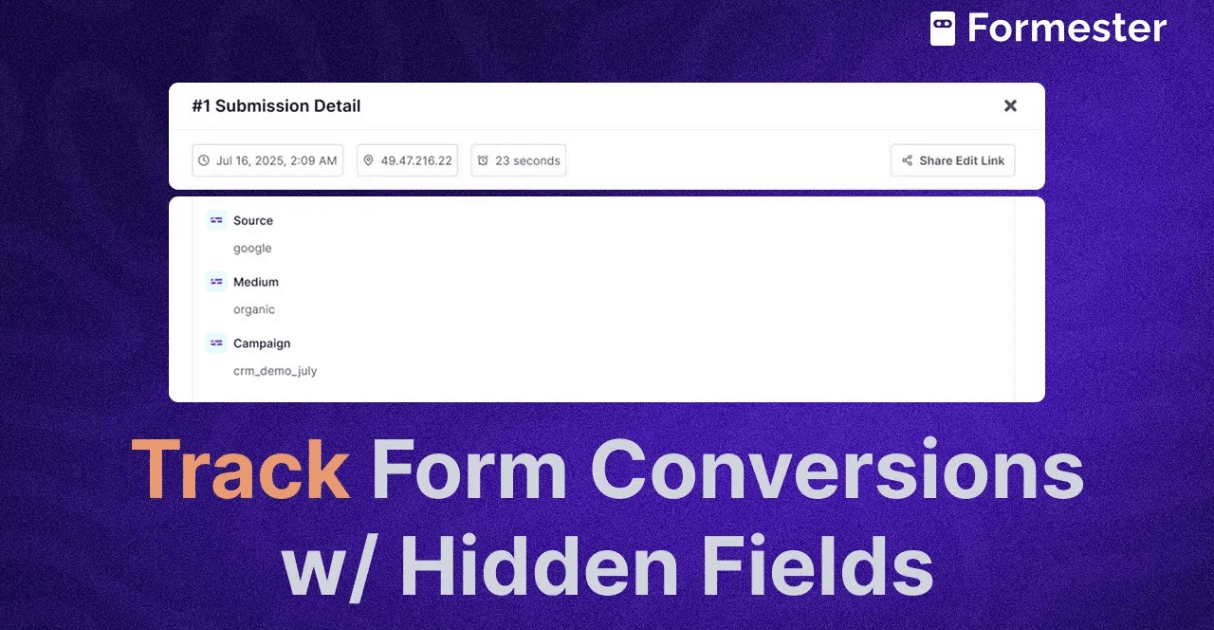What is web form spam, and how to prevent it?
Websites have been here for a while, and so are web forms. Businesses use web forms for various use cases ranging from lead generation, feedback, newsletter signup, and even for taking customer order details. Despite forms being very useful, they also serve as a breeding ground for pests — electronic pests, which we can call bots.

These bots are pre-programmed with keywords and a list of forum or website URLs. They crawl or visit these URLs and fill in the web forms with these keywords. These are useless submissions for the business, and this is what we call SPAM.
These submissions are useless and increase the time to go through the accurate data. They hamper lead generation, analytics, and even sales. So, the problem is obvious, and nobody wants spam submissions in their forms. Form spam can originate from various sources, making it difficult to prevent it entirely. Despite this, understanding the origin and the reason for spam can help reduce it.
Where does the spam come from?
Understanding the source of form spam can help you reduce these submissions in your forms.
- Manual Spamming - Manually spamming involves humans filling out forms with false information and harmful links. They do so primarily to establish backlinks to their site, which may help them in search engine results. Sometimes these links can be malicious and feed the users with malware. Other times they may steal other users' personal information or scam them for money. This all reduces your website reputation and hampers user interaction. Since human spammers can bypass almost all validations, there is a tiny that one can do to stop them.
- Spam Bots - These are pre-programmed bots to search for forms and input fields around the web and fill them with keywords or links. The number of submissions they can make can be significant as they are automated; hence, they are the most irritating. These bots have hundreds of variations; applying a single static technique to filter them all is impossible. One has to follow efficient methods to filter maximum spam bots.
Is it essential for your business to stop form spam?
Whether it's a WordPress site or a website built from the ground up with the help of web development languages. If a business depends on this website, it's essential and beneficial to prevent spam. Some of the major issues which a business face because of spam:-
- Slow Response time - If your forms are blotted with spam, for example, your website's contact form, then the time to respond to genuine users will increase. Someone must manually go through the submissions pile to filter out the genuine ones. Slow response, in turn, might cause inconvenience to the users and may lead to customer loss. Slow response time irritates real users, and in the era where every other thing has an alternative, your users will start moving to search for another solution.
- Bad user experience and reduced brand value - A webpage with a poorly controlled comment section is often full of spam comments. For example, links to other websites, hate speech, links left by scammers, and much more. All of these factors contribute to a bad user experience and a loss of brand reputation.
- Safety and security concerns - Sometimes, the links posted by the spammers on your site lead to malware; hence, ensuring your visitors' safety becomes very important.
- Hampered Analytics - Form spam artificially increases the number of website visits, making it difficult to differentiate between genuine and spam visits. It hampers analytics and our understanding of the organic traffic the website is attracting.
What can you do to stop form spam?
In addition to being unwanted, form spam is also harmful. It is, therefore, imperative to prevent them, while at the same time, we cannot eradicate them. Here are some ways to avoid form spam:-
Enable Recaptcha - Recaptcha is a simple yet powerful solution provided by Google. It replaces the traditional captcha (Completely Automated Public Turing test to tell Computers and Humans Apart). Although captchas were highly effective, they were somewhat annoying to users, which resulted in a drop in submissions.
Unlike captcha, which was tests done to identify humans and bots, respectively, ReCaptcha is a simple checkbox with some code behind it. It asks users to confirm that they are not robots. It is simple and does not require extra time. They are practical and can block spam registrations on your site or spam submissions on your forms.
Honeypots - Spam can come through almost any field; however, the most common ones are name and email fields. We can use this knowledge to our advantage with the help of honeypots.
Honeypots are extra input fields that are invisible to regular users. They commonly consist of name and email fields and are programmed so that they are only visible to bots. Input to these fields remains empty for regular users since they aren't visible. Bots, however, can fill in these extra fields. Spam submissions that contain inputs in those additional fields are automatically flagged.
Honeypots are very efficient and are a great alternative to captcha as they do not come in the way of user experience.
Validate all submitted data - Validation refers to verifying whether the submitted information is admissible. There are many validations, including simple checks to ensure a field is not empty. Another example would be to check whether the email is valid or if the password should be alphanumeric. One can show a related error message if an input is invalid. Although validation slows down a form submission, it is very effective against spam.
Time analysis - Bots take significantly less time to fill a form than an average human. By understanding the average minimum time it will take a person to fill up your form, one can easily flag all submissions done in significantly less time. Tracking should begin when the user clicks on the first field and continue until the user submits the form.
However, there is a catch here. With the autofill feature, filling forms take relatively less time than usual. So, one has to do quite a bit of research before implementing this.
Email verification - An email verification process verifies that the email address entered by a user is valid and belongs to the user. It can be done by sending a verification link to the email address entered by the user.
The form link can be emailed directly to the recipient after verifying the email. Most bots can't go through this step, so your forms will be free from spam. Human spammers can bypass this step but often don't want to since they tend to spam via use and throw emails.
Not allowing links - If unnecessary, one should avoid taking in links since the spammers' primary goal is to establish website backlinks or to leave malicious URLs. Not allowing links will reduce the number of spam.
Blocking or limiting IP Addresses - IP addresses can be restricted to prevent spam if many submissions come from a single source over a given period. Such activities are usually malicious and shall be blocked.
Adding questions in form submissions - Putting a simple question field can help identify spam submissions. Questions like the "Number of days in a week" or mathematical questions like "10 + 20" are simple and can be answered by anyone. When robots fill these fields with random keywords, it becomes easier to distinguish legitimate submissions from spam submissions.
Anti-spam plugins - If you are running a WordPress site, you can easily find many anti-spam plugins. These plugins can help you protect your contact forms, comment sections, registration form, and more from spam. Installing and setting them up is usually relatively easy. Some of the popular anti-spam plugins are:-
Can Formster help you fight form spam?
Formester forms come with spam protection built in. A form created with Formster is significantly more secure thanks to features such as ReCaptcha, IP address limitations, and data validation. If adding preventive measures to your forms manually looks daunting, you can give Formester a spin. Building forms with formester is painless and can be done in minutes.
Online Form Spam FAQ:
1) How to stop bots from submitting forms?
Ans. Completely eliminating bots is difficult, but you can deter them with a layered approach. Employ CAPTCHAs like Google reCAPTCHA, utilize hidden "honeypot" fields to trap bots, implement time limits for form completion, and consider country or keyword filtering if you see specific spam patterns. Additionally, double opt-in forms, where users confirm their email address, can further reduce bot-generated submissions.
2) How to prevent form spam without captcha?
Ans. While CAPTCHAs can be effective, alternative methods exist for preventing form spam. Utilize "honeypot" fields that only bots fill, leverage form validation rules to check for suspicious data patterns (like nonsensical characters or impossible dates), and consider real-time verification tools to analyze submission behavior and flag potential bot activity. Additionally, IP blocking can further enhance your defenses.

